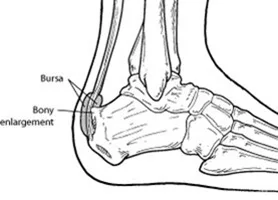What Is Haglund’s Deformity?
Haglund’s deformity is characterized by a bony protrusion at the heel’s rear. It leads to irritation of nearby soft tissue, specifically the Achilles tendon, when this growth rubs against footwear, which can result in bursitis, an inflamed bursa – a cushioning, fluid-filled sac located between bone and tendon.
Causes of Haglund’s Deformity
This condition, also known as “pump bump,” is commonly associated with the pressure exerted by the stiff backs of pump-style shoes upon walking. Other shoes with rigid backs, like ice skates, men’s dress shoes, or women’s pumps, can also trigger this irritation.
Genetics can predispose individuals to Haglund’s deformity, particularly through inherited foot structures such as:
- A high-arched foot
- A tight Achilles tendon
- A tendency to walk on the heel’s outer side
Symptoms of Haglund’s Deformity
The deformity can manifest in one or both feet, with symptoms including:
- A discernible bump on the heel’s back
- Pain at the site where the Achilles tendon is connected to the heel
- Heel swelling
- Redness around the inflamed tissue
Diagnosis of Haglund’s Deformity
A foot and ankle surgeon will assess symptoms and physically examine the foot. Typically, healthcare providers order X-rays to further evaluate the bone structure of the heel.
Nonsurgical Treatment
Nonsurgical methods aim to alleviate bursal inflammation but do not decrease bony enlargement. These methods may involve:
- Medication: NSAIDs like ibuprofen are recommended for mitigating pain and inflammation.
- Ice: Use an ice pack on the swollen area with a thin towel as a barrier. Apply ice for 20 minutes with at least a 40-minute break before reapplying.
- Exercises: Achilles tendon stretching exercises can reduce tension.
- Heel lifts: For high-arched individuals, heel lifts inside the shoe might lessen heel pressure.
- Heel pads: Cushioning heel pads inside the shoe can decrease irritation when moving.
- Shoe modification: Shoes without a back or those with a soft back can help prevent or minimize irritation.
- Physical therapy: Techniques like ultrasound can reduce inflammation.
- Orthotic devices: Custom arch supports help manage foot movement.
- Immobilization: Casting might be necessary in certain cases.
When Is Surgery Needed?
If nonsurgical treatments do not sufficiently alleviate pain, the patient may require surgery. The foot and ankle surgeon will determine the most appropriate surgical method and provide postoperative care instructions.
Prevention
To minimize the risk of Haglund’s deformity recurring:
- Wear shoes with a soft heel back or those without a rigid heel.
- Use orthotic devices or arch supports.
- Perform stretching exercises to keep the Achilles tendon flexible.
- Avoid running on hard surfaces or uphill.
Why Choose a Foot and Ankle Surgeon?
Podiatrists, DPMs, or foot and ankle doctors often refer to foot and ankle surgeons, who possess extensive education and training dedicated to foot and ankle care. They have expertise beyond other healthcare providers in this arena.
Foot and ankle surgeons handle a plethora of foot and ankle conditions, regardless of complexity, and cater to patients of all ages. They are proficient in various surgical procedures, including those potentially required for treating Haglund’s deformity.



